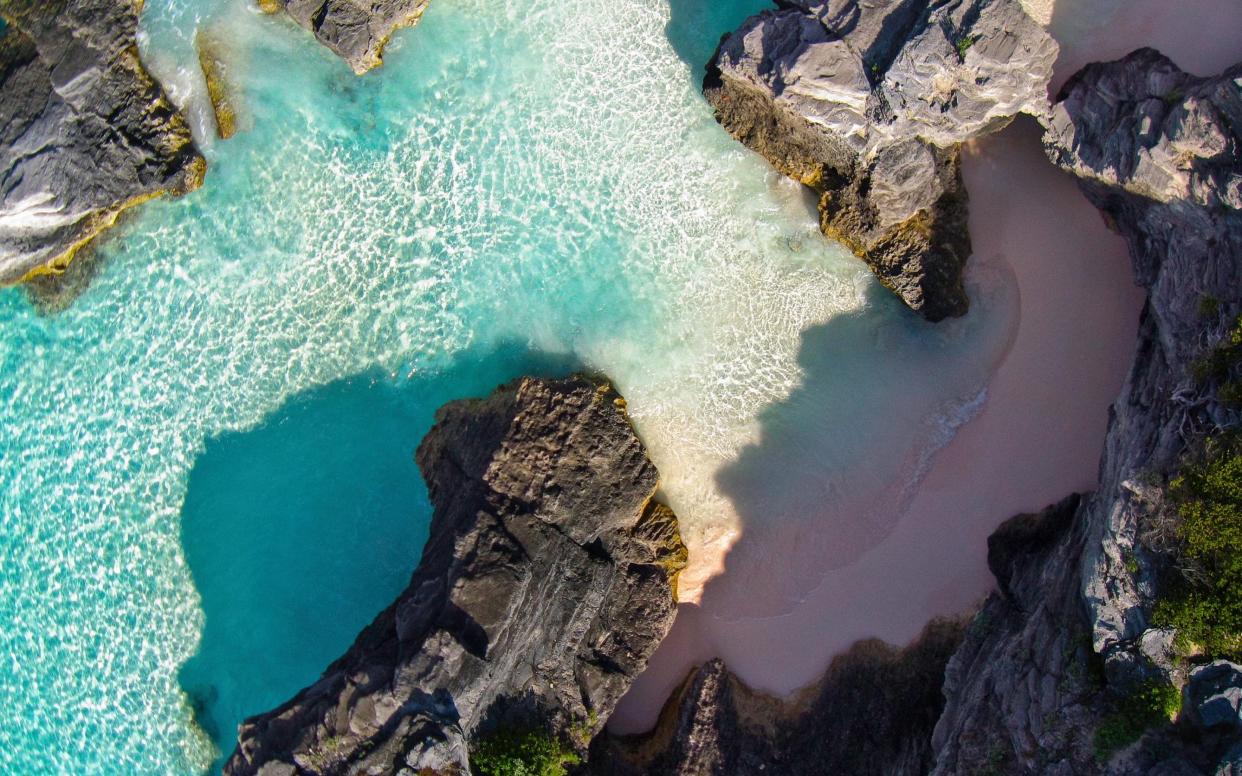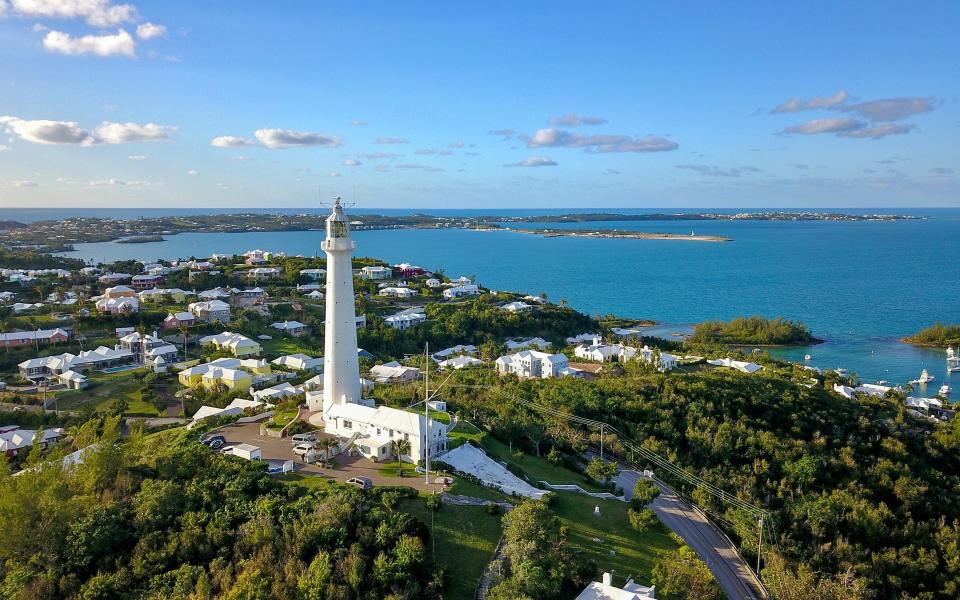Why Bermuda is greatest place to be right now

Bermuda island reserve might sound like a bottle of rum but it is, in fact, the extra fuel that aircraft must carry to ensure they can safely divert. Carrying island reserve is not a common practice; it is employed only for the most remote locations. But this British Overseas Territory is one of those, properly out there in the middle of the Atlantic, not far off 700 miles from the nearest land (Cape Hatteras, North Carolina).
Referred to locally as “The Rock”, Bermuda’s isolation might be becoming its strong suit – with its fresh salty air, brisk winds, and yet a delightfully mild climate allowing for outdoor living. We long to breathe deeply, mask-free again, and there might be few better places than this fishhook-shaped archipelago, clustered together in a chain of tortile islands connected by causeways and dinky bridges. Looking out across the Atlantic expanse from its striking jagged coastline, fringed with pink-sand beaches, it really does feel a long way from the crowds, the congestion, the crisis. There’s even a neighbourhood called Faraway, in case you were in doubt.
I felt a wave of freedom on landing, a strangely unfamiliar sensation. That was in part down to the approach: seeing peachy clouds at sunset, rippled aquamarine seas below, and the land dotted with sherbet coloured houses. But my sense of escape was also connected to Bermuda’s rigorous Covid protocols: visitors must undertake a test before departing their place of origin; they must test on landing; and they must have regular tests throughout their stay. That might sound hugely inconvenient but the reality is less so, for example, much of the testing is carried out in a rather old-fashioned post office, there’s neither queue nor faff (and a modest price tag, see fact box). The outcome of these practices is a pass to a near-Covid free world.
Landing late in the evening, my first test was at the airport. From there, I took a taxi to my hotel where I needed to stay in my room until receiving notification of a negative result. I sat on the balcony, watching boats chug past, ordering room service as the stars came out. In the morning, I checked my phone to find a text informing me of my negative result. I had the all-clear. Suddenly I was free. Against the backdrop of a rinsed blue sky, crisp air and the sun beating down, I borrowed a bicycle from the hotel, map in hand, and pedalled off to the ferry terminal in the capital Hamilton.

I caught a boat to the former Royal Naval Dockyard, a joyful 20-minute journey across the lagoon. It was here on the Great Sound that the last America’s Cup was held three years ago, when so many British hopes were pinned on the team of Ben Ainslie, the world’s most successful Olympic sailor. These calm waters were also where flying boats landed before the airport was constructed in the 1940s, during the Second World War.
The ferry docked opposite two stocky tug boats, Faithful and Powerful, and I alighted on the wharf, wheeling my bicycle alongside me, before setting off to explore the 19th-century bastions and ramparts, palm-stocked cloisters and cast iron-frame buildings, now turned into boutiques and grills. During the America’s Cup, this was the site of the competitors’ village and there’s a monumental foiling catamaran of the winning Oracle Team USA positioned at a precarious angle, high in the air.
From here, I cycled south-west, coming across the handsome Royal Naval Cemetery with its gently undulating, trimmed lawns, and headstones etched with such old-fashioned words as “a token of regard” or “of respect” or as “a mark of esteem”. The dates indicated most of the dead had passed away before even their 30th birthday; either who “fell victim to the yellow fever” or were “stricken and died of typhus fever”, or who drowned after capsizing, or collapsed from sunstroke. Some of the stone markers were scattered with mould, or broken, making the words unintelligible. There was someone whose name I couldn’t read, “found drowned at Bermuda, April 25, 1891”, and another nameless who “departed this life” on “Sept the 26th, 1860; Aged 27 years”.
Wistful, I crossed the road to a slip of a beach, also unnamed, at least on my map, to clear my head with a swim. I had worn my bikini under my clothes and so stripped off and jumped in.

Looking north-west out across the expanse of sea, studying the horizontal bands of blues, I knew the nearest land to be about 800 miles away, probably New York; south, it was 1,000 miles to the British Virgin Islands; and 2,000 miles east to the Azores. For a moment, I felt alone in the middle of the ocean. But then every 20 minutes or so, a pink-coloured public bus rumbled past, mostly empty of passengers, and an odd boat put-putted by, following white markers home.
After shaking myself dry and warmed by sunshine, I continued to Somerset Station to meet up with the Bermuda Railway Trail, which traverses nearly the entire island up to St George’s in the north-east. At the time of its construction nearly 100 years ago, it cost more per mile to build than almost any other railway in the world, and was also considered one of the most picturesque of train journeys. The trail today follows the old tracks, removed now, and the views are still sensational. I had the trail almost to myself, passing only a couple of dog-walkers and one jogger.
From time to time, I took a break on the benches intermittently positioned overlooking the water. Sometimes I lost the trail, meandering on to the road, and I eventually diverted to the southern beaches, after stopping at the gleaming white Gibbs Hill Lighthouse.

When I made it back to my hotel, it was almost dark. The grande dame on the island, the Hamilton Princess dates back 130-plus years, and has a fabled history hosting New York and London society. During the Second World War, it served as an intelligence hub intercepting mail, radio and telegraphic traffic, a kind of Bletchley-in-the-Tropics, as some call it.
More recently the property has undergone a makeover with new owners housing some of their remarkable art collection here; in the lobby, an Anish Kapoor hangs alongside Andy Warhols; there’s a Banksy tucked behind an Ai Weiwei sculpture, as well as artworks by Damien Hirst and Jeff Koons. Bermuda is a surprising blend of castaway and global player.
Another day I took a boat to see Bermuda from the water. Larry Dean, the captain, told me that before operating the pleasure cruiser, he had spent 20 years working in search and rescue. I appealed to him for some Bermuda Triangle stories, but he disappointed me saying that there’s actually not much marine traffic around the islands. Perhaps daunted by the treacherous rocks? I persisted. “The rocks aren’t as bad as you think,” he replied, smiling. “It’s a matter of hit and miss.” He paused for a moment. “Of course, it’s always better to miss.”
Larry indulged me by taking me to the site of a wreck, partly peeping above the water line. We also had a spontaneous stop, tying up at a waterside eatery to grab a traditional fish sandwich (wahoo in raisin bread) before returning via Two Rock Passage, which splits Little Sound from Great Sound in Hamilton Bay.
As the sun slipped below the horizon, Larry sighed: “The fact that this beautiful island exists in the middle of the ocean is a miracle.”
On my remaining days I set about exploring in a hired Renault Twizy, a kind of souped-up golf buggy. It turns out visitors are not actually allowed to hire cars, in an effort to lessen traffic. I headed to the former capital St George’s, where Bermuda was first settled in 1609 by survivors of the wrecked Sea Venture.

Here is the oldest Protestant church in the New World, between lanes with names such as Featherbed Alley, recalling a hard-drinking husband who arrived home late to find his wife had thrown their bed out of the window and who then passed out on the mattress in the street; there is also Shinbone Alley, named after the drunken sailors who crawled home after leaving the town’s taverns.
When I visited it was ghostly quiet. Most of the shops were closed, in spite of it being the middle of the day. Opening hours handwritten on the door of St George’s Historical Society Museum were Wednesday and Saturday 10am-4pm. There was certainly a different rhythm here.
On my last day I returned to the southern beaches and found my favourite slip of sand, tucked behind Astwood Park, where a steep trail leads down to a dainty cove. Nobody was about and I swam solo, breathing in the fresh Atlantic air like it was my last gasp.
Returning to my Twizy, I saw a foursome on the cliffs, sitting on yoga mats, overlooking the ocean; they waved at me. Life had become so daydreamy here that on my return to the car park, I got in the wrong Twizy. When my key didn’t work in the ignition, I checked the gauges before realising my mistake. I exited sheepishly, noticing all the sand I had deposited on the seat. At the same time, the yoga buffs were arriving back in the car park.
“No worries,” one of them said laughing. “We do it all the time.” He helped me to sweep out the sand, while his friend reached out her hand to introduce herself. It was to be the first hand I’d shaken in months.
Bermuda feels different to anywhere else right now, a snapshot of the good old days, existing on its own meridian. I have a feeling if anywhere’s going to flourish in the future, it might be here.
Essentials
Travellers (aged 10 years and up) need a negative RT-PCR Covid test and travel certificate carried out within seven days of their flight to Bermuda. My Healthcare Clinic (020 7099 5555; myhealthcareclinic.com) operates six sites in London where tests are administered by a registered professional and processed by Ukas-approved and PHE-endorsed laboratories (£149). A negative result and certificate is required to apply for Bermuda’s Travel Authorisation, which costs $75 (£57) and is to be filled out online one to three days before flying (gov.bm/coronavirus-travellers). On arrival, travellers will test at the airport, and on days four, eight and 14 of their visit.
The Hamilton Princess hotel (thehamiltonprincess.com), the grande dame on the island, is within walking distance of the town and the ferry terminal, and has a fleet of bicycles and e-bikes for guests to borrow. The hotel operates a regular complimentary shuttle bus to its private beach club on the south side of the island. Rates start at $299 per night.
British Airways (ba.com) has resumed its direct service to Bermuda with fares from London Gatwick starting at £515. Bermuda’s new airport terminal officially opened on Wednesday
There are travel restrictions in force throughout the UK governing trips both within the country and abroad. For regional variations, see gov.uk/coronavirus; gov.scot/coronavirus-covid-19; gov.wales/coronavirus.

